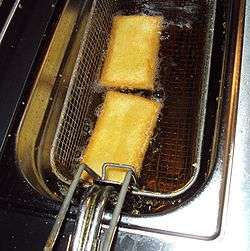Tortilla chip
|
A plate of tortilla chips and dips | |
| Type | Snack food |
|---|---|
| Place of origin | Mexico |
| Main ingredients | Tortillas (corn, vegetable oil, salt, water) |
|
| |

A tortilla chip (/tɔːrˈtiː.ə tʃɪp/, Spanish: [torˈtiʎa tʃip]) is a snack food made from corn tortillas, which are cut into wedges and then fried—or baked (alternatively they may be discs pressed out of corn masa then fried or baked). Corn tortillas are made of corn, vegetable oil, salt and water. Although first mass-produced in Los Angeles in the late 1940s,[1] tortilla chips were always considered to be a Mexican food, known as totopos and tostadas.[2] Though usually made of yellow corn, they can also be made of white, blue, or red corn. Some manufacturers include many other ingredients including wheat, sugar, and monosodium glutamate.
History
The triangle shaped tortilla chip was popularized by Rebecca Webb Carranza as a way to make use of misshapen tortillas rejected from the automated tortilla manufacturing machine that she and her husband used at their Mexican delicatessen and tortilla factory in southwest Los Angeles. Carranza found that the discarded tortillas, cut into triangles and fried, were a popular snack, and she sold them for a dime a bag at the El Zarape Tortilla Factory. In 1994, Carranza received the Golden Tortilla award for her contribution to the Mexican food industry.[1]
Tex-Mex and Mexican cuisine
Tortilla chips are the quintessential and often complimentary appetizer in Tex-Mex and Mexican restaurants in the U.S. and elsewhere. Their popularity outside of California saw a steady rise in the late 1970s when they began to compete with corn chips, the dipping chip of choice during the first three quarters of the 20th century. They are typically served with a dip, such as salsa, chile con queso, or guacamole. When not served with a dip, the chips are often seasoned with herbs and spices. Although they are now available worldwide, the United States is one of the main markets for tortilla chips. Commercial brand names for tortilla chips include Phileas Fogg snacks, Tostitos, Doritos, and Don Tacos (in Japan).
A more elaborate dish utilizing tortilla chips is nachos. First created circa 1943 by Ignacio "Nacho" Anaya,[3][4][5] nachos are tortilla chips served with melted or shredded cheese, although often other toppings are added or substituted, such as meat, salsa (such as pico de gallo), refried beans, guacamole, sour cream, diced onions, olives, and pickled jalapeños. More elaborate nachos are often baked for a short period of time to warm the tortillas and melt shredded cheese.
Corn chips
A similar fried corn snack is the corn chip, which is not made from a tortilla, but from corn meal which has been processed into a particular shape, typically a small scoop. Fritos are an example of this.[6] The principal difference between the corn in tortilla and corn chips is that the corn in a tortilla chip has undergone a process known as nixtamalization, which involves processing the raw corn with quicklime.[7] Both tortilla and corn chips are referred to as "corn chips" in Australia and Oceania.
See also
References
- 1 2 Associated Press (24 February 2006). "Rebecca Carranza; a pioneer of the tortilla chip; 98". The San Diego Union-Tribune. Union-Tribune Publishing Co. Retrieved 17 July 2011.
- ↑ Arnold, Oren (10 April 1939). "Romance Inc. - Chapter 40". Painesville Telegraph. p. 8. Retrieved 18 July 2011.
Tostados - crusty toasted tortillas - were served [to] them.
- ↑ Orr, Adriana P. (July 1999). "Nachos, anyone?". OED News. Oxford University Press. Archived from the original on 2 January 2010. Retrieved 26 July 2011.
- ↑ Haram, Karen. "The History of the Nacho". San Antonio Express-News. Archived from the original on 6 March 2009. Retrieved 28 June 2012.
- ↑ Haram, Karen (14 February 2002). "The Legend of Nacho's Appetizer". Sun Sentinel. Sun Sentinel. Retrieved 18 July 2011.
- ↑ "The Birth of the Frito". National Public Radio. 18 October 2007. Retrieved 2 August 2008.
- ↑ Caballero-Briones, F.; et al. (June 2000). "Recent advances on the understanding of the nixtamalization process". Superficies y Vacío. Mérida, Yucatán, Mexico: Sociedad Mexicana de Ciencia de Superficies y de Vacío. 10: 20–24. ISSN 1665-3521.
External links
| Wikimedia Commons has media related to Tortilla chips. |
- Olsson, Karen. "Why Are Tortilla Chips So Damn Good?" - Texas Monthly - September 2009
- Tortilla Industry Association "http://www.tortilla-info.com"
